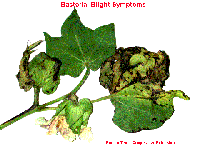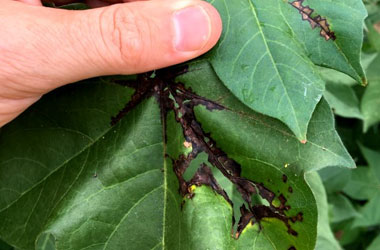

The term “race” means a form of the pathogen that will infect susceptible varieties of cotton but not those with resistance to “Race 18”. Additionally, for a number of years, it is believed that the predominant form of XCM present in our cotton fields is “Race 18”. The addition of “pv malvacearum” is nomenclature that this form of the bacterial pathogen is very specific in the species of plants it will affect, likely only cotton. The causal agent of bacterial blight is Xanthomonas citrii pv malvacearum (XCM), a pathogen whose name has changed several times over the past 125 years. Without question, bacterial blight is a more important problem for cotton growers in Georgia than it has been in a number of years. This is not meant to diminish the importance of the disease, but rather an attempt to keep the current impact of the disease in proper perspective. But I believe that in a significant effort to document where the disease is today, we may be finding symptoms at very low levels that could have been there in the past as well. Quite the contrary, for it was they who brought this disease to the forefront for growers. This does not mean in any way that agents, consultants and scouts were not diligent in previous seasons.

Second, we (in a general sense with consultants often in the lead) are scouting and looking much harder for bacterial blight than we have in the past. It is known that other varieties are susceptible to this disease as well. First, in 2015 growers planted a highly susceptible variety, DPL 1454 B2RR which clearly sustained losses to bacterial blight. Certainly two things have changed as of the 2015 season. When bacterial blight is not severe, symptoms may be difficult to detect as time and energy are focused on more important concerns. Although not commonly reported since I started in 2000 I have seen examples of the disease, to include leaf spots and infected bolls, over the years. Whatever the reason, appreciation is expressed to the consultants, Extension agents and growers who have worked very hard over the past two seasons to document the impact and spread of this disease.īacterial blight is not a new disease to cotton in Georgia and was likely in some of our fields even before this current outbreak. We could be dealing with a new and more virulent strain of the pathogen. There could have been a new introduction of the bacterial pathogen into our cotton fields. Some of the newer varieties could be more susceptible. Beginning in 2015 and continuing into 2016, bacterial blight has been more visible in Georgia’s cotton then it has been in a number of years. In case you have already subscribed for the Article/Publication, please login, using the panel provided above.įor Information regarding subscription please click here.įor a comprehensive list of other publications available on indianjournals.Cotton growers in Georgia are understandably concerned about the impact of bacterial blight on their cotton yields.

Only one genotype, AKA-7 showed resistance towards Xanthomonas axonopodis pv. Thirty germplasm lines of cotton (16 of Gossypium hirsutum group and 14 of G.

Panjabrao Deshmukh Krishi Vidyapeeth, Akola (MS) 41372Īn experiment was conducted at Cotton Research Unit, Dr. Malvacearumĭepartment of Plant Pathology, Dr. BIOINFOLET - A Quarterly Journal of Life SciencesĮvaluation of Cotton Genotypes Against Xanthomonas Axonopodis pv.


 0 kommentar(er)
0 kommentar(er)
